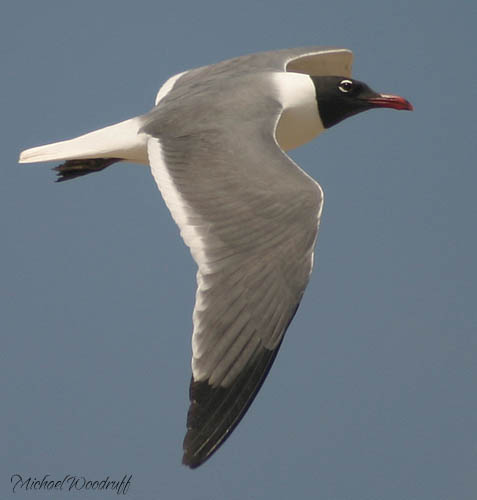m (References updated) |
(→Taxonomy: Update link) |
||
| Line 21: | Line 21: | ||
==Taxonomy== | ==Taxonomy== | ||
====Subspecies==== | ====Subspecies==== | ||
| − | This is a [[Dictionary_M- | + | This is a [[Dictionary_M-O#M|polytypic]] species consisting of two subspecies<sup>[[#References|[1]]]</sup>: |
*''L. a. megalopterus'': | *''L. a. megalopterus'': | ||
:*South-eastern [[California]] to western [[Mexico]]; [[Maine]] to Central America; winters to [[Peru]] | :*South-eastern [[California]] to western [[Mexico]]; [[Maine]] to Central America; winters to [[Peru]] | ||
| Line 32: | Line 32: | ||
Image:607-13901fg Second Summer Laughing Gull.jpg|Second Summer <br />Photo by {{user|bobsofpa|bobsofpa}}<br />Fort Island Trail Beach, Crystal River, [[Florida]], [[USA]], August 2007 | Image:607-13901fg Second Summer Laughing Gull.jpg|Second Summer <br />Photo by {{user|bobsofpa|bobsofpa}}<br />Fort Island Trail Beach, Crystal River, [[Florida]], [[USA]], August 2007 | ||
</gallery> | </gallery> | ||
| + | |||
==Habitat== | ==Habitat== | ||
Coastal islands, saltmarshes and sand-dunes. | Coastal islands, saltmarshes and sand-dunes. | ||
Revision as of 16:49, 1 July 2014
- Leucophaeus atricilla
Larus atricilla
Identification
L. 36-41 cm
W. 98-110 cm
One of two North American dark-backed hooded gulls.
Field marks include dark almost slate colored back, small white primary tips, large bill, narrow eye-arcs, and extensive hood (in breeding plumage).
Nonbreeding has limited remnants of hood and black bill.
Juveniles have totally black primary tips, gray neck, and black bill.
Similar species
Bonaparte's Gull is smaller with much lighter gray back, smaller black bill (in all plumages), and with almost no white on primary tips.
Black-headed Gull is slightly larger with much lighter gray back, less extensive hood, and with mostly no white to primary tips.
Franklin's Gull is a slightly smaller dark-backed hooded gull with larger white primary tips (even in juvenal plumage), much less extensive black in wingtips when flying, broader eye-arcs, and smaller thinner bill. Juvenile Franklin's have whitish neck (instead of gray).
Distribution
Year-round resident on eastern and southern coastline of the U.S. from Maine to the southern tip of Texas.
Winters in Mexico.
Rare away from east coast and south coast of the U.S. but with records in almost every state.
Vagrant to Europe with several records annually in the UK.
Taxonomy
Subspecies
This is a polytypic species consisting of two subspecies[1]:
- L. a. megalopterus:
- South-eastern California to western Mexico; Maine to Central America; winters to Peru
- L. a. atricilla:
- West Indies to Trinidad; winters to northern Brazil
Some authorites place it in the genus Larus.
Juvenile
Photo by bobsofpa
Bombay Hook National Wildlife Refuge, Delaware, USA, August 2008
First Summer
Photo by bobsofpa
Flamingo, Everglades National Park, Florida, USA, April 2008
Habitat
Coastal islands, saltmarshes and sand-dunes.
Behaviour
Often gathers in large flocks in beachfront areas on lawns, park areas, parking lots, etc.
Diet
Omnivorous - diet includes fish, insects, carrion, mollusks, eggs, worms, young birds, etc. Collects food by foraging on beaches and shallows; does not submerge in search of food like some other shorebirds.
They are scavengers as well as hunting small prey.
Breeding
A large nest is built of grass and placed on the ground. 3-4 greenish eggs are laid and incubated for about 21 days.
Vocalisation
A laugh-like ha, ha, ha, ha. Also a yelp similar to Common's kee-agh
References
- Clements, J. F., T. S. Schulenberg, M. J. Iliff, B.L. Sullivan, C. L. Wood, and D. Roberson. 2013. The eBird/Clements checklist of birds of the world: Version 6.8., with updates to August 2013. Downloaded from http://www.birds.cornell.edu/clementschecklist/download/
- Collins Field Guide 5th Edition
- Collins Bird Guide ISBN 0 00 219728 6
Recommended Citation
- BirdForum Opus contributors. (2024) Laughing Gull. In: BirdForum, the forum for wild birds and birding. Retrieved 8 May 2024 from https://www.birdforum.net/opus/Laughing_Gull
External Links








